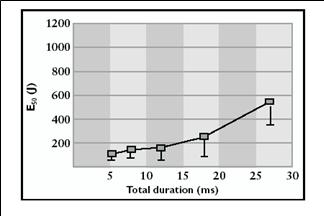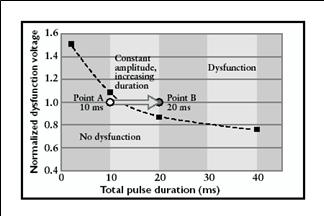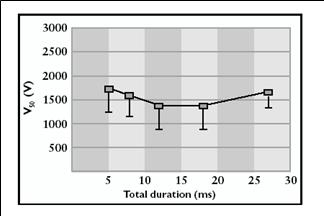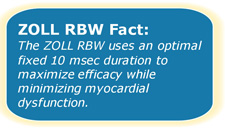Biphasic Technology - Optimal Duration
Optimal Duration for Defibrillation Shocks
The ZOLL Rectilinear BiphasicTM waveform (RBW) is different from other biphasic waveforms in the way it treats duration. The ZOLL RBW fixes duration at 10 msec, regardless of patient impedance, to optimize the influence of the strength-duration curve.
The duration of a biphasic defibrillation shock has a significant influence on the efficacy of the shock. Early research on biphasic waveforms established the strength duration relationship-the amount of voltage or energy required to reach defibrillation thresholds as a function of time.
Figure 1 shows the voltage required to achieve a 50% likelihood of defibrillation. As the duration on the biphasic shock increases, the amount of voltage required initially declines. However, once the duration extends beyond about 10-12 ms, the amount of voltage required just to achieve the same efficacy actually increases. Similarly, when energy requirements are plotted as a function of time, the amount of energy required to achieve the same efficacy increases as the duration of the shock increases.
Figure 2
Research by Jones and Milne also describes the relationship between biphasic shock duration and myocardial dysfunction.
Figure 3 plots the voltage needed to product a 4-second postshock contractile arrest against duration. Biphasic waveforms with amplitude/duration coordinates below the dysfunction threshold curve (dashed line) did not cause myocardial dysfunction while those above the line resulted in dysfunction. For instance, a biphasic waveform located at Point A is below the dysfunction threshold curve and thus will cause no dysfunction
Simply increasing the duration, while the voltage remains constant, will result in a waveform that causes myocardial dysfunction. In this case, increasing the duration from 10 ms to 20 ms results in an approximately 15% reduction in safety margins. The longer the duration of the biphasic waveform, the less voltage was required to produce myocardial dysfunction.
Other biphasic waveforms 'compensate' for patient impedance by extending the duration of equation, it does not deliver more current to the heart.
More importantly, shock durations that extend beyond 10-12 ms actually reduce efficacy and may increase the risk of myocardial dysfunction.
Read on to uncover the unique advantages of ZOLL's Rectilinear Biphasic waveform:
Principles of Electricity
More Current at 200 J than other biphasic waveforms at 360 J
Optimal Duration for Defibrillation Shocks
Superior for Cardioversion of Atrial Fibrillation
Superior for Defibrillation of Ventricular Fibrillation
Superior for Defibrillation of Out-of-Hospital Cardiac Arrest
Pediatric Biphasic Recommendations
Bibliography




